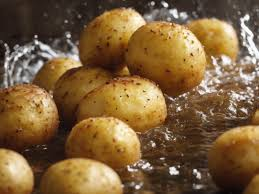Potatoes are one of the most versatile foods in the kitchen. Whether you are preparing crispy fries, creamy mashed potatoes, or roasted wedges, how you handle them before cooking plays a major role in the outcome. One of the most common steps professional chefs and home cooks swear by is soaking potatoes in cold water before cooking. While this might seem like a simple trick, there is solid science behind why soaking makes such a big difference in texture and flavor.
Why Soaking Works
The primary reason soaking potatoes matters is starch removal. Potatoes naturally contain a high amount of starch, especially varieties like russets. When you slice or cut a potato, some of this starch is released onto the surface. If left untouched, the excess starch can make potatoes stick together and prevent them from achieving that golden-brown crispness during frying or roasting.
Soaking the cut potatoes in cold water helps rinse away the surface starch. This allows the potato pieces to cook more evenly and develop a firmer, crisper texture on the outside while maintaining a soft interior. This step is very important for getting the right bite of foods like French fries or hash browns.
The Role of Cold Water
It’s not just the soaking that matters—it’s soaking in cold water specifically. Cold water helps firm up the potato’s cell structure, preventing it from becoming mushy during cooking. Warm or hot water, on the other hand, may cause some of the starch to gelatinize too early, leading to a gummy texture.
By keeping the potatoes submerged in cold water for at least 30 minutes, or even overnight, you give them the best chance of delivering both crispness and tenderness once they hit the pan or oven.
Do Raw Potatoes Lose Nutrients When Soaked?
A common concern among health-conscious cooks is: do raw potatoes lose nutrients when soaked? The answer is yes, but only to a small extent. If you let potatoes soak for a long time, especially overnight, water-soluble vitamins like vitamin C and some B vitamins can leak out into the water. However, the loss is usually minimal when potatoes are soaked for just 30 minutes to a few hours.
If nutrient retention is a top priority, aim to limit soaking time to what is necessary for texture improvement, and avoid cutting potatoes too far in advance. You can also use the soaking water in soups or stocks to reclaim some of the nutrients that might have leached out.
Best Practices for Soaking
To get the most out of soaking potatoes while minimizing nutrient loss, here are a few simple tips:
- Cut Consistently – Whether you are making fries, cubes, or slices, keep the size uniform so the soaking works evenly and the potatoes cook at the same rate.
- Use Ample Cold Water – Make sure the potatoes are fully submerged so starches are effectively drawn out.
- Avoid Excessive Soaking – For most recipes, 30 minutes to 2 hours is sufficient. Overnight soaking is fine for convenience, but it can cause slightly more nutrient loss.
- Dry Before Cooking – After soaking, pat the potatoes dry with a clean towel. Removing excess moisture helps them crisp up rather than steam.
Final Thoughts
Soaking potatoes in cold water before cooking isn’t just an old kitchen myth—it’s a scientifically proven method for achieving perfect texture. By washing away surface starch and strengthening the potato’s structure, soaking leads to crispier fries, fluffier mash, and more evenly cooked dishes. While some nutrient loss can occur during soaking, it’s generally minimal and can be managed by limiting soaking time and reusing the soaking water creatively.
In short, if you want your potato dishes to consistently impress, this simple step is worth adding to your cooking routine.
read more : THC Tea for Sale in Canada A Soothing New Way to Enjoy Cannabis
